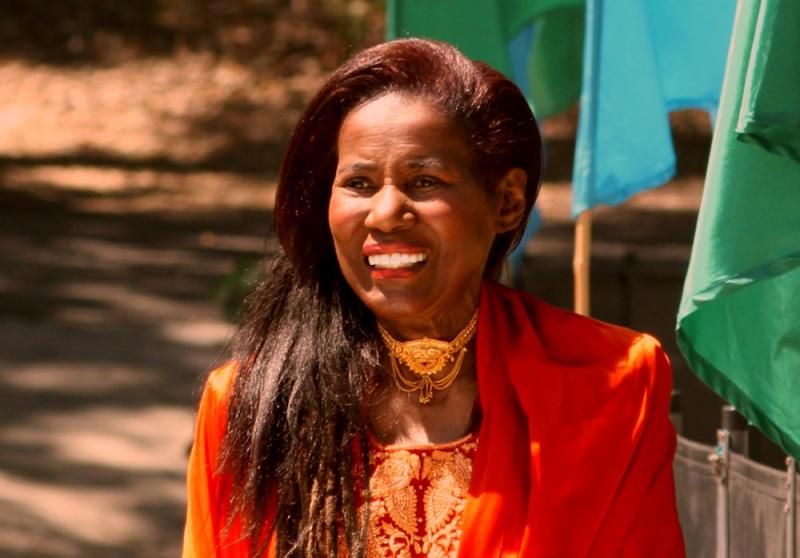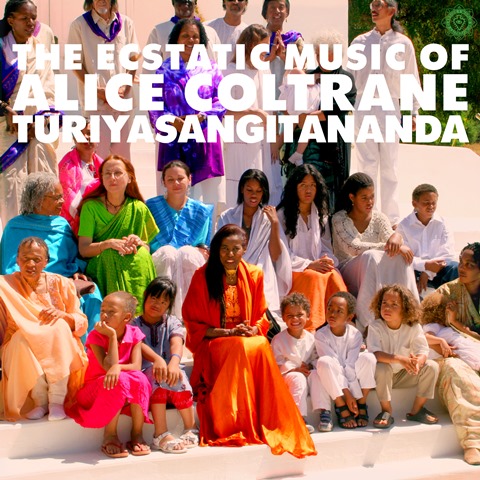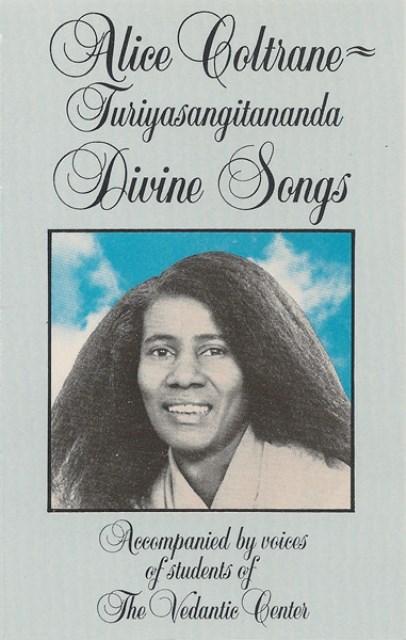Reissue CDs Weekly: Alice Coltrane | reviews, news & interviews
Reissue CDs Weekly: Alice Coltrane
Reissue CDs Weekly: Alice Coltrane
Startling, essential collection of previously obscure music recorded at a California ashram

A strong candidate for reissue of the year, World Spirituality Classics, Volume 1: The Ecstatic Music of Alice Coltrane Turiyasangitananda is a rarity amongst archive collections as it does what is always hoped for but seldom accomplished. A new story is told, the music is unfamiliar but wonderful, and it has been put together conscientiously.
The Ecstatic Music of Alice Coltrane Turiyasangitananda collects tracks – eight on the CD edition, 10 on the vinyl set – recorded between 1987 and 1995 which initially had limited circulation. The original releases drawn from were issued by the Avatar Book Institute: a division of California’s Vedantic Center, based at the Sai Anantam Ashram which Coltrane (1937–2007: her husband, John Coltrane, died in 1967) established in the first half of the 1980s.
 She was a unique composer/musician with a string of more easily available recordings behind her. Albums for the Impulse! and Warner Bros labels such as 1971’s Universal Consciousness and 1977’s Transcendence attested to her spirituality and uncategorisably fused be-bop, free jazz, gospel music, what became known as new age music and Eastern-inspired modality. Musicians as disparate as Sunn O))) and Paul Weller have paid tribute to her.
She was a unique composer/musician with a string of more easily available recordings behind her. Albums for the Impulse! and Warner Bros labels such as 1971’s Universal Consciousness and 1977’s Transcendence attested to her spirituality and uncategorisably fused be-bop, free jazz, gospel music, what became known as new age music and Eastern-inspired modality. Musicians as disparate as Sunn O))) and Paul Weller have paid tribute to her.
Consequently, the appearance of a collection of barely heard tracks recorded while her public profile was (relatively) low is important. Significantly, what is heard is unlike anything else she issued previously. As the words “Ecstatic Music” in the title make clear, what’s collected is devotional and not aimed a conventional audience. Nonetheless, within the opening seconds of the first track “Om Rama” this extraordinary music firmly makes its case with a glorious beauty and power.
Her signature instruments were traditional keyboards (organ: including the Wurlitzer; piano: including the electric Fender Rhodes) and the harp. At the Sai Anantam Ashram she acquired the analogue Oberheim OB8 synthesizer, on which she created string-like swells and seamlessly swooped through the scale. She also had an organ and like-minded collaborators who contributed flute, percussion, solo vocal, strings and gathered as a massed chorale. Amongst them was Panduranga Henderson who, as John Henderson, had sung with Ray Charles. Making music fully defined by the world within which she lived, Coltrane also sang for the first time. It must be stressed that this is not amateur, lo-fi material but precisely arranged, fully produced and lush recordings which could have been tracked in a professional studio.
 Paying no heed to the outside world generated a music lacking spatial and temporal reference points. Heard cold, it is impossible to judge where and when this music is from. Rhythm beds the bulk of tracks and intertwines with modal, circular Sanskrit chanting. Organ and synthesiser (the harp is played on one track) are colour. Each composition builds, layer upon layer, from one climax to another like a series of ecstatic waves breaking. Ragas are an influence. There is also gospel call and response. The percussion, especially on “Om Rama”, brings to mind that of Jamaica’s Nyabinghi rasta.
Paying no heed to the outside world generated a music lacking spatial and temporal reference points. Heard cold, it is impossible to judge where and when this music is from. Rhythm beds the bulk of tracks and intertwines with modal, circular Sanskrit chanting. Organ and synthesiser (the harp is played on one track) are colour. Each composition builds, layer upon layer, from one climax to another like a series of ecstatic waves breaking. Ragas are an influence. There is also gospel call and response. The percussion, especially on “Om Rama”, brings to mind that of Jamaica’s Nyabinghi rasta.
That this is a music beyond time and place is stressed by the astonishing “Journey to Satchidananda”, a keyboard-focused composition so intense that with barely any recasting it could snugly fit – regardless of the language employed by vocalist by Sai Ram Iyer – onto the similarly affecting and transcendent 21st-century albums of Anna von Hausswolff and Susanne Sundfør.
Three cassettes and a CD are drawn from. Bootlegs of two have appeared over the past decade on CD and vinyl. The original master tapes are the source here. “Rama Katha” is selected from Turiya Sings (cassette, 1982); “Er Ra”, “Hari Narayan”, “Keshnava Murahara”, “Om Shanti Divine” and “Rama Rama” are from Divine Songs (cassette, 1987: pictured above left); “Krishna Japaye” and “Om Rama” are from Infinite Chants (cassette, 1990); “Journey to Satchidananda” is from Glorious Chants (CD, 1995). It is not made clear where and when “Rama Guru” originally appeared as a track with this title appeared on Divine Songs and Infinite Chants. World Spirituality Classics, Volume 1: The Ecstatic Music of Alice Coltrane Turiyasangitananda is copiously annotated and endorsed by Coltrane’s family.
Get this. It is very special.
Share this article
The future of Arts Journalism
You can stop theartsdesk.com closing!
We urgently need financing to survive. Our fundraising drive has thus far raised £49,000 but we need to reach £100,000 or we will be forced to close. Please contribute here: https://gofund.me/c3f6033d
And if you can forward this information to anyone who might assist, we’d be grateful.

Subscribe to theartsdesk.com
Thank you for continuing to read our work on theartsdesk.com. For unlimited access to every article in its entirety, including our archive of more than 15,000 pieces, we're asking for £5 per month or £40 per year. We feel it's a very good deal, and hope you do too.
To take a subscription now simply click here.
And if you're looking for that extra gift for a friend or family member, why not treat them to a theartsdesk.com gift subscription?
more New music
 Album: Mansur Brown - Rihla
Jazz-prog scifi mind movies and personal discipline provide a... complex experience
Album: Mansur Brown - Rihla
Jazz-prog scifi mind movies and personal discipline provide a... complex experience
 Album: Reneé Rapp - Bite Me
Second album from a rising US star is a feast of varied, fruity, forthright pop
Album: Reneé Rapp - Bite Me
Second album from a rising US star is a feast of varied, fruity, forthright pop
 Album: Cian Ducrot - Little Dreaming
Second album for the Irish singer aims for mega mainstream, ends up confused
Album: Cian Ducrot - Little Dreaming
Second album for the Irish singer aims for mega mainstream, ends up confused
 Album: Bonniesongs - Strangest Feeling
Intriguing blend of the abstract, folkiness, grunge and shoegazing from Sydney
Album: Bonniesongs - Strangest Feeling
Intriguing blend of the abstract, folkiness, grunge and shoegazing from Sydney
 Album: Debby Friday - The Starrr of the Queen of Life
Second from Canadian electronic artist and singer offers likeable, varied EDM
Album: Debby Friday - The Starrr of the Queen of Life
Second from Canadian electronic artist and singer offers likeable, varied EDM
 Music Reissues Weekly: The Pale Fountains - The Complete Virgin Years
Liverpool-born, auteur-driven Eighties pop which still sounds fresh
Music Reissues Weekly: The Pale Fountains - The Complete Virgin Years
Liverpool-born, auteur-driven Eighties pop which still sounds fresh
 Album: Indigo de Souza - Precipice
US singer's fourth ups the pop ante but doesn't sacrifice lyrical substance
Album: Indigo de Souza - Precipice
US singer's fourth ups the pop ante but doesn't sacrifice lyrical substance
 Album: Mádé Kuti - Chapter 1: Where Does Happiness Come From?
Lively new album from the third generation of Nigeria's first musical family
Album: Mádé Kuti - Chapter 1: Where Does Happiness Come From?
Lively new album from the third generation of Nigeria's first musical family
 The Human League/Marc Almond/Toyah, Brighton Beach review - affable 1980s-themed seaside package
Retro pop extravaganza bolstered by a (mostly) balmy evening
The Human League/Marc Almond/Toyah, Brighton Beach review - affable 1980s-themed seaside package
Retro pop extravaganza bolstered by a (mostly) balmy evening
 Album: Alice Cooper - The Revenge of Alice Cooper
The original Alice Cooper band are back to fly the flag for all the weirdos
Album: Alice Cooper - The Revenge of Alice Cooper
The original Alice Cooper band are back to fly the flag for all the weirdos
 Album: Paul Weller - Find El Dorado
Inspiring curation of some pretty great covers, and hints of majesty
Album: Paul Weller - Find El Dorado
Inspiring curation of some pretty great covers, and hints of majesty
 Album: Spafford Campbell - Tomorrow Held
The young duo extend folk’s boundaries into an expansive contemporary chamber music
Album: Spafford Campbell - Tomorrow Held
The young duo extend folk’s boundaries into an expansive contemporary chamber music

Add comment